The dictionary card catalog
THE record, of most practical use is the catalog, which is the key to the resources of the library. It is a record on cards of all the bound books in the library. Each book may have several cards. One card gives the author on the top line as a heading, another gives the title, and another the subject. All the cards should be arranged alphabetically according to the first word on the top line.
Such a catalog will show how many books there are in the library by a given author, who wrote certain books which are better known by title than by author, and all the books about specific subjects, such as Salesmanship, Bonus system, Moving pictures, Russia - History, or U. S. - Army.
The consensus of opinion among librarians of wide experience as organizers is that Library of Congress printed cards cannot be used to advantage by untrained librarians. These cards are often very confusing to both librarian and the public. In adapting them to local use more time is required and more information is necessary than in the making of brief typewritten cards. Library of Congress printed cards are , therefore, not recommended for small libraries.
Typewritten cards are preferred to handwritten. Cards for both shelf list and catalog should be of standard library size, 7.5 x 12.5 centimeters. It is well to use the best possible quality which will stand long use without rewriting. Cat. no. 33025 is recommended for typewriter, as the ruling is a guide in keeping the indentions uniform ; Cat. no. 33020P for plain cards ; Cat. no. 33022 for handwriting. In estimating the number of cards needed for a dictionary catalog containing author, title, and a moderate number of subject cards, an average of five cards for each volume should be allowed. •
Author card
The f irst card to be made for every book is called the author or main card. For the sake of uniformity the spacing and information given should be as follows, the numbers referring to the typewriter scale, assuming that the usual size type is pica.
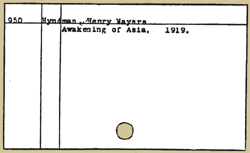
- Insert the card at O.
- Write the class number on the top line at 1. (This number shows the location of the book on the shelves.)
- On the top line at 8 (the first vertical line) write the author's name in its best-known form, with surname first to aid in alphabetizing.
- Continue the name at 13 if too long for one line. Compare the form of an author's name each time it occurs with the form first chosen, for the sake of keeping the author entries uniform.
- On the next line below the author's name, at 12 (the second vertical line), write the title of the book as it appears on the title-page. If a long title, begin succeeding lines at 8 (the first vertical line) .
- The illustrator's, translator's, or editor's name may follow the title if important, separ ated from it by a semicolon.
- Omit apital letters except for proper names and the first word of the title.
- Place a period at the end of the title.
- Give the date of publication found on the title-page, or when none appears, use the last copyright date.
- Omit dates for all books of fiction.
- Three spaces after the title give the number of volumes if more than one.
Title card
Every book which will be asked for by a distinctive title should have a title card.
If a secondary or catch title is better known than the full title, a title card under the catch title will be more useful, example: "Tom Sawyer" not"Adventures of Tom Sawyer."
The cards should be made as follows :
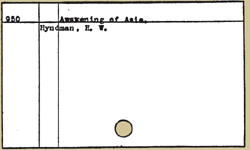
- Write the class number in the same position as on the author card.
- On the top line at 12 (the second vertical line) write the short title of the book following the title-page (not the back of the book), omitting initial articles, The, A, or An.
- Continue the title on the second line at 13 if too long for one line.
- If more than one volume, indicate the number three spaces after the title.
- Write the author's name on the first line below the title at 8 (the first vertical line), placing the surname first, followed by a comma, and the initials only of the forenames.
Subject cards
In addition to author and title cards, it is necessary to make subject cards for non-fiction books, in order to make available all the reference material in a library.
The subject or subjects of the book are selected by examining the table of contents or introduction and by reading the book itself. The title of the book alone is frequently misleading as to the real subject of the work
Careful choice of headings is necessary, and for consistency, the A. L. A. "Subject headings for use in dictionary catalogs" (Cat.no. 1045) should be consulted for books for adults and the A. L. A. "Subject headings for use in dictionary catalogs of juvenile books" (Cat. no. 1047) for juvenile books. These manuals should be checked for future reference and will be a help in selecting proper cross references. The A. L. A. "Booklist" and the "Reader's guide to periodical literature" are also helpful in the choice of headings. Subject cataloging should not be undertaken without careful study of all available printed aids. (See list at end of this pamphlet.)
When the proper subject headings have been selected, each subject card is written as follows :
All capital letters will emphasize the subject heading without requiring the use of a red ribbon
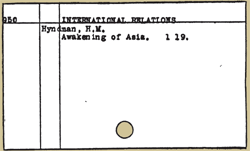
- Class number in the same position as on author and title cards.
- The subject heading on the top line at 12 on the typewriter scale (the second vertical line).
- The author's surname on the first line below the subject heading at 8 (the first vertical line), placing the surname first, followed by a comma, and the initials only of the forenames.
- The rest of the card, beginning with the title, is an exact copy of the author card.
Analytics
A separate entry for a distinct chapter or part
of a book with page reference which it covers ia called an analytic. As many of these analytics as are considered useful should be made. Important subject, author, or title analytics may be made for parts not shown on the cards for the whole book. The smaller the library, the more the need for many subject analytics, in order to make available all the subject material which will be of use in reference work. 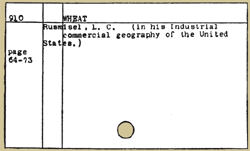
The subject analytic is similar in form to a full subject card with the addition of the exact paging written one line below the last line of the title. This is to aid the eye in quick reference.
Author analytics are not as necessary as subject, but if needed may be made according to the following example
Title analytics are made only for well-known titles which would otherwise be lost. Example:
Illustrators
Cards for noted illustrators will be convenient if one wishes to know what works the library has which are illustrated by important artists. Example : Added entry for important illustrator
Tracing
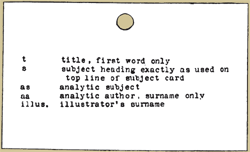 A tracing is a very important record made on the back of the main author card showing all the additional cards, so that in case the book is lost or withdrawn all the cards for the book may be removed. Tracing is indicated in abbreviated form and the typing is so placed on the reverse of the author card that it may be read without removing the card from the catalog.
A tracing is a very important record made on the back of the main author card showing all the additional cards, so that in case the book is lost or withdrawn all the cards for the book may be removed. Tracing is indicated in abbreviated form and the typing is so placed on the reverse of the author card that it may be read without removing the card from the catalog.
The cut shows the reverse of a main author card with the position of tracing.
Arrangement of cards in the catalog
All cards are arranged in alphabetical order similar to the words in a dictionary, following each word on the top line of the card, but disregarding initial articles The, A, or An. Alphabet by the first word that differs, when the words on the top line are the same for two or more cards. Study the rules in Hitchler's "Cataloging for small libraries," p. 262-269 ; Wilson's "School library management," p. 89-94; and in "An apprentice course for small libraries," p. 24-25. Try to keep in mind the reader who knows no rules and avoid arbitrary arrangements as much as possible.
Card guides
Use a sufficient number of guides to assist the reader in finding what he wants. A guide every twenty-five cards is not too many. Guides with plain tabs, half cut, are recommended for small libraries, as they are interchangeable in position, and give greater space for the headings. Printed guides with celluloided tabs and carefully selected headings should be purchased for larger libraries, as they save the librarian much time. (Cat. nos. 431500L, 431500S, 431250C, 43165.)
Shelf labels
No library may be considered complete in its organization without proper shelf labels, which assist both the reader and the librarian in finding the books readily.
It is quite as important that a library should be well marked with shelf labels as it is for a city to be well provided with street signs. It is much easier for the searcher to read signs than it is to ask questions. Printed labels which fit all Library Bureau label holders are available and are more legible than handprinted labels. They bear the chief class numbers and the subject words they represent. Various sets have been compiled to meet the requirements of actual collections of books, from which a selection may be made to fit individual needs. (Cat. nos. 1376, 1377, 1378, 1379, 1383, 1384.)
Classification chart
Another very desirable help in the intelligent use of the library is a celluloid chart to hang on the end of a bookcase or on the wall near the shelving. Upon this are printed the one hundred divisions of the classification shown on p. 6-7. (Cat. no. 1046.)
Card catalog chart
To aid the reader in the use of the dictionary card catalog, a brief printed explanation with a few illustrations should be provided. This is available in two printed forms, one on celluloid, a companion piece to the classification chart, intended to hang near the catalog, and another in the form of a guide card for use in each drawer of the card catalog cabinet. (Cat. nos. 1048, 1195.)
Periodicals
IN any library it is important to keep a record of the current periodicals in order to show whether all the copies to date have been received, also to give information as to expirations, renewals of subscriptions, cost, etc.
Specially ruled cards are much used for this purpose. They provide a convenient method and ample space for checking daily, weekly, and monthly publications. ( Cat. nos. 1105.1, 1106.1.)